Introduction
In India, many farmers and urban growers are stuck between rising fertilizer prices, unpredictable monsoons, and shrinking arable land. Even city folks passionate about growing food are left wondering where to begin.
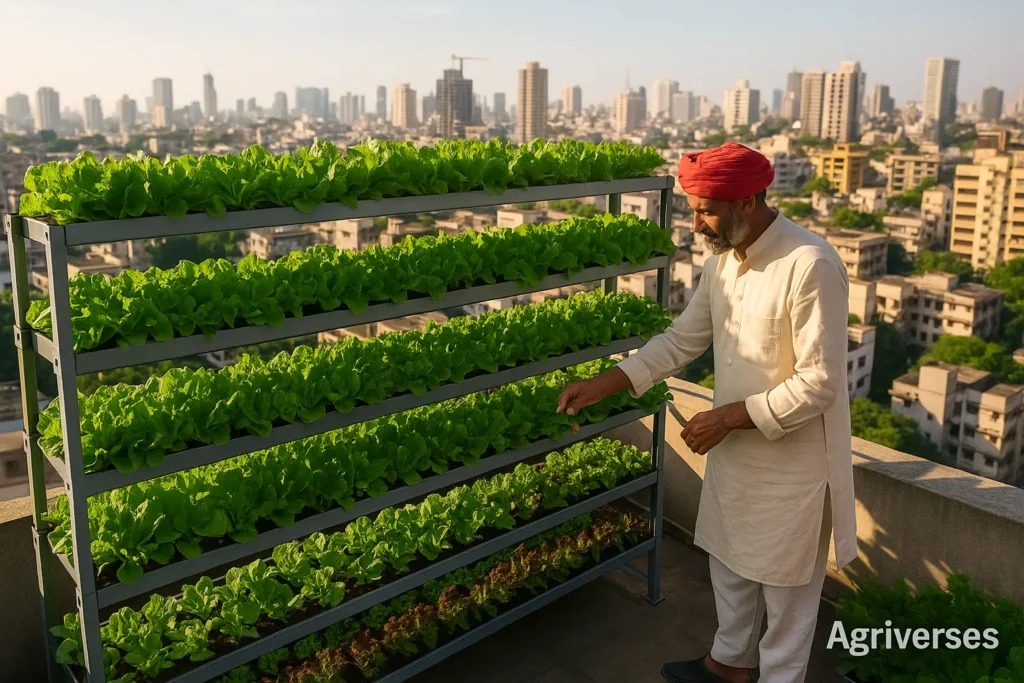
Amidst these challenges, a new ray of hope is emerging: vertical urban farming. This modern farming style promises to solve space issues, reduce input costs, and bring food production closer to our kitchens—even in a high-rise flat or abandoned mall.
Let’s explore how urban vertical farming is reshaping the future of food, especially in our crowded cities.
Don’t have a terrace? You can still grow at home—read our Beginner’s Guide
What Makes Urban Vertical Farming Unique?
Urban vertical farming is more than just stacking plants in towers. It’s a shift in mindset—from rural dependency to localized food production. At its core, it uses vertical space, hydroponics or aquaponics, controlled lighting, and nutrient-rich water instead of soil.
Unlike traditional farming, where land is everything, vertical systems allow people in cities to grow vegetables, herbs, and even microgreens right inside buildings. Imagine tomatoes growing on your window wall or spinach growing in a repurposed parking lot.
This setup reduces the need for transportation (lowering carbon footprints), gives year-round yield, and empowers citizens to grow organic produce free from pesticides. Plus, it cuts down the middlemen—your food literally comes from your wall to your plate!
Rooftop Models & Abandoned Building Setups
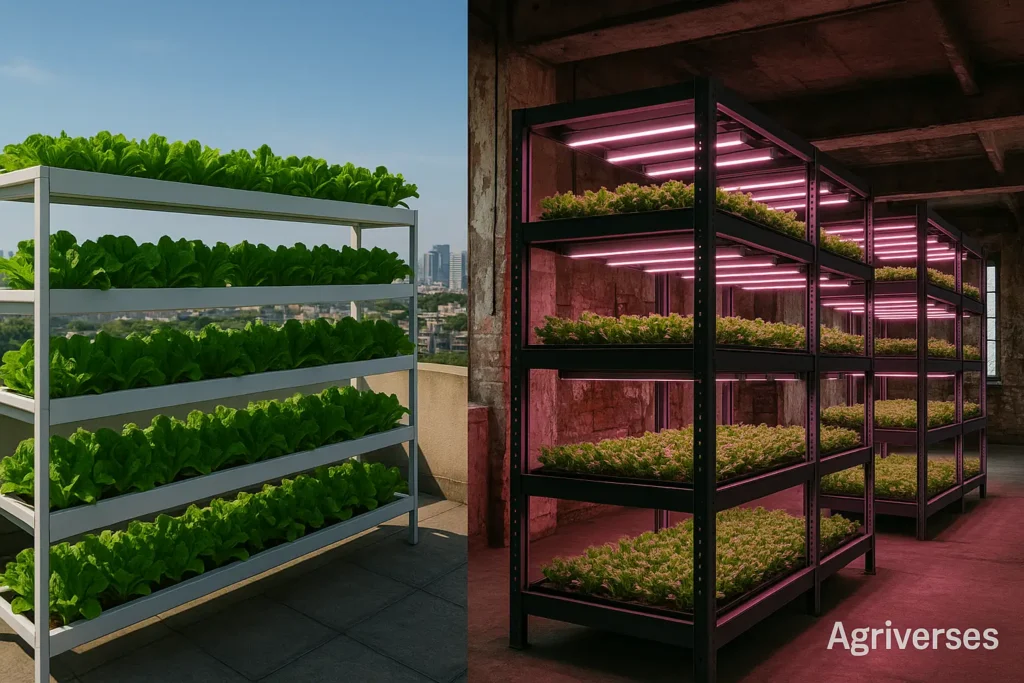
One of the most exciting aspects of urban vertical farming is how creatively it uses underutilized urban spaces. Rooftops, which often lie vacant or unused, are being converted into lush green zones producing food.
In cities like Delhi, Pune, and Chennai, startups and NGOs are helping housing societies set up rooftop greenhouses. With modular racks, polyhouses, and automated drip systems, even a 500 sq. ft terrace can produce several kilos of leafy greens every week.
Abandoned buildings—like defunct malls or factories—are becoming indoor vertical farms. These closed spaces offer a controlled environment where temperature, humidity, and light can be adjusted to mimic ideal growing conditions.
I recently visited a pilot project near Bengaluru where an old warehouse was turned into a vertical hydroponic spinach farm. Clean, efficient, and futuristic – you wouldn’t believe it used to be a cement godown!
Organic Challenges in Urban Areas

Vertical farming has its benefits, but doing it organically in urban areas comes with its own set of hurdles.
1. Water Quality Issues:
Most city water is treated with chlorine or contains heavy metals. This can harm plant roots and hard water (high in salts) affects nutrient uptake.
Farmers using hydroponics or aquaponics need pre-filtration systems or RO-treated water. Some use rainwater harvesting combined with biochar filtration to maintain purity.
2. Air Pollution & Its Effects:
Cities are not exactly clean. Particulate matter, smog, and carbon emissions can settle on crops and reduce photosynthesis.
Plants absorb particles from the air. In cities with high PM 2.5 levels, leaves can gather toxic dust. The solution? Installing green mesh barriers, using activated carbon air filters, and planting indoor-compatible varieties like lettuce, basil, or spinach that thrive in controlled environments.
While these challenges sound technical, many urban growers are finding jugaadu (innovative) solutions—from growing inside shaded balconies to using neem-based organic sprays to tackle dust mites.
Mastering the Technical Aspects
- Understanding the science behind urban vertical farming helps ensure success. Plants need specific nutrient ratios at different growth stages, just like children need different foods as they grow. The nutrient solution acts as both soil and fertilizer, delivered directly to plant roots.
- pH levels require constant monitoring—most vegetables prefer slightly acidic conditions between 5.5-6.5. I always tell new urban farmers to invest in a good pH meter and testing kits. These tools cost less than ₹5,000 but prevent crop failures worth thousands.
- Lighting represents the biggest ongoing expense after initial setup. LED grow lights consume electricity, but their efficiency continues improving while costs decrease. Many urban farmers reduce electricity bills by running lights during off-peak hours or investing in solar panels for energy independence.
- Pest management in vertical systems differs significantly from traditional farming. While controlled environments reduce pest pressure, any problems that do arise can spread quickly in dense growing conditions. Beneficial insects, neem-based solutions, and maintaining plant diversity help manage pests organically.
- Temperature control becomes crucial during Indian summers. Ventilation fans, shade cloth, and evaporative cooling systems help maintain optimal growing conditions without excessive energy consumption.
Want a step-by-step plan to get started? Go through our Vertical Farming Starter Guide.”
Global & Indian Success Stories
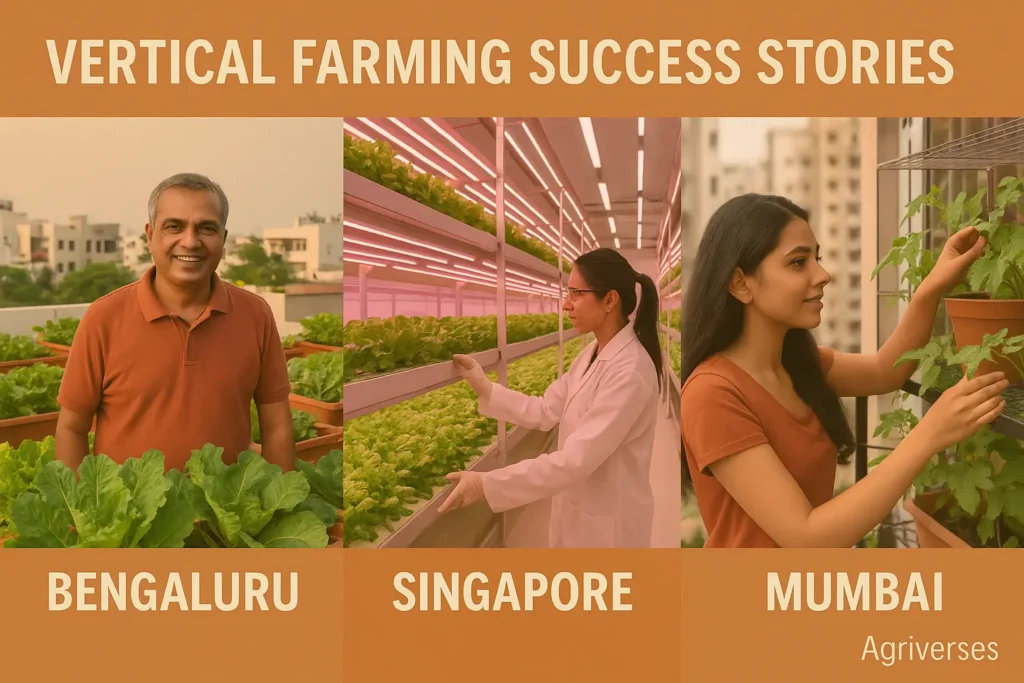
Let’s take inspiration from real stories. Singapore, one of the most urbanized nations, now boasts vertical farms like Sky Greens, where vegetables grow in rotating towers powered by gravity and water.
Closer home, in Bengaluru, a company called “Agritechies” set up a hydroponic vertical farm inside an old IT office. They grow kale, basil, and cherry tomatoes and sell directly to restaurants and apartment communities.
Another inspiring tale comes from Maharashtra where a group of women in a tier-2 city converted their housing society’s terrace into a thriving farm. Today, they grow 15+ organic veggies and even sell surplus produce to local shops.
These examples prove that whether you’re in a high-rise or a chawl, vertical urban farming can be your path to self-sufficiency.
Future Trends in Urban Organic Farming
Urban farming is no longer a fringe hobby. It’s becoming a movement. With AI-driven sensors, IoT devices, and mobile-controlled irrigation systems, we’re seeing a new wave of smart agriculture enter city spaces.
Drone-assisted nutrient spraying, app-based pest tracking, and LED lighting that mimics sunlight are being explored. Plus, with the growing popularity of organic lifestyle choices, urban dwellers are demanding chemical-free, hyper-local produce.
Govt schemes like PM Kusum Yojana or Agri-Start-up Grants are also encouraging urban agripreneurs. Even educational institutes like ICAR and KVKs are offering short-term urban farming workshops.
If this trend continues, we might soon see vertical farms as common as coffee shops in metros. Imagine visiting a mall and picking fresh coriander or strawberries grown right there—fresh, organic, and local.
How This Technique Can Empower Smallholders
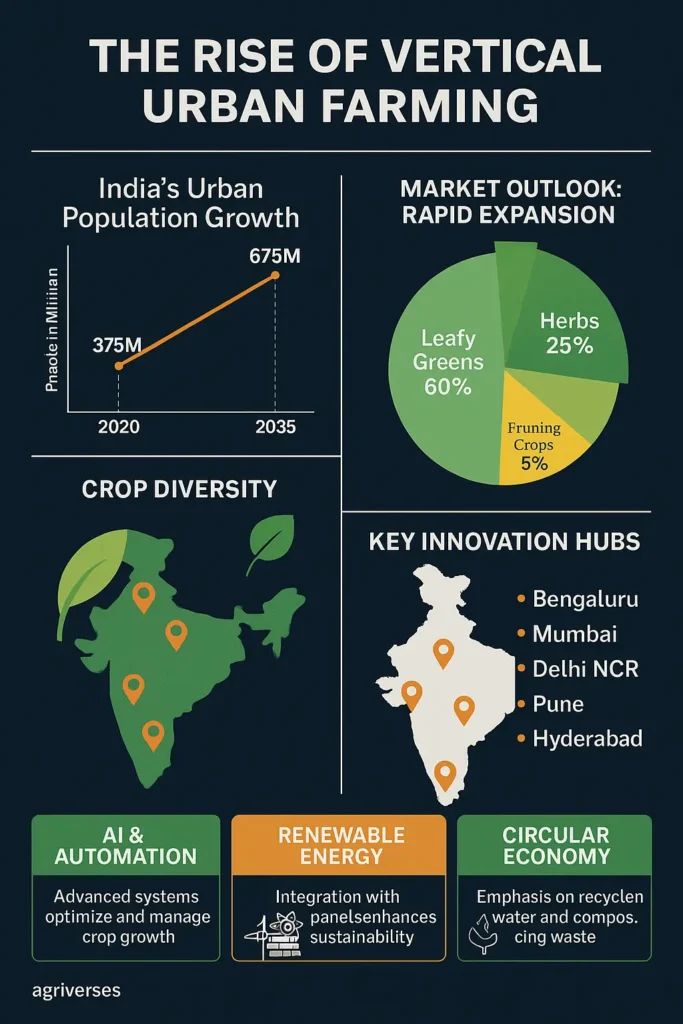
At first glance, urban vertical farming may seem like a big city idea. But imagine if smallholders near peri-urban zones adopted it. With limited land and growing pressure from real estate, many farmers near cities are being forced to sell.
But with vertical methods, even 200 sq. ft can generate income. Farmers can grow microgreens, salad veggies, or herbs and sell them to city-based cafes or through subscription models.
This approach can help reduce migration, increase farm profitability, and build a direct connection between growers and consumers. Plus, it opens up job opportunities for women, youth, and even retired citizens.
As a farmer myself, I often say this: “Kheti ka future sirf zameen pe nahi, deewar aur chhat pe bhi likha jaa raha hai.”
Conclusion: Why Vertical Urban Farming Matters
In a world where cities are swelling and soil is shrinking, vertical urban farming isn’t just a trend—it’s a timely solution. From rooftop setups to hydroponic towers inside malls, this model is practical, scalable, and most importantly, hopeful.
It merges ancient values with modern innovation—bringing food closer, making it cleaner, and connecting people back to their roots. Whether you’re a techie in Bengaluru or a farmer’s child in Azamgarh, there’s space in this movement for everyone.
If you found this valuable, do share it with fellow farmers or agri-students. Want more such insights?
Follow Agriverses or explore our Organic Farming series.
A Greener, Smarter Rural Future
Our country’s strength has always been in its soil. But as the soil gets pushed out of cities, it’s time we grow upwards. Vertical farming, especially organic models, offer a new lifeline for India’s food security.
It’s not just about growing coriander on a balcony; it is about rethinking how we feed ourselves. If India invests in training, tech, and terrace gardens, we can empower a whole new generation of urban farmers.
And who knows? The next Green Revolution might just rise—not from Punjab’s fields, but from the rooftops of Mumbai.
External References
ICAR Hydroponic Research Projects
Urban Farming in Singapore – FAO Case Study
Krishi Jagran – Urban Agri Startups India

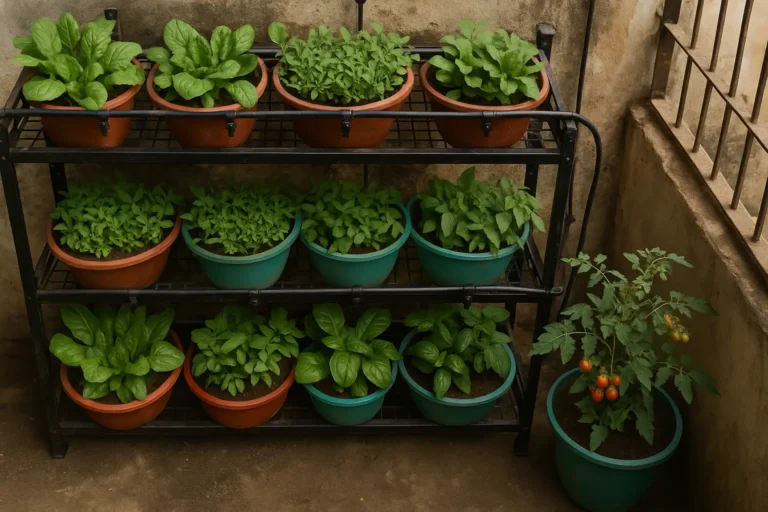



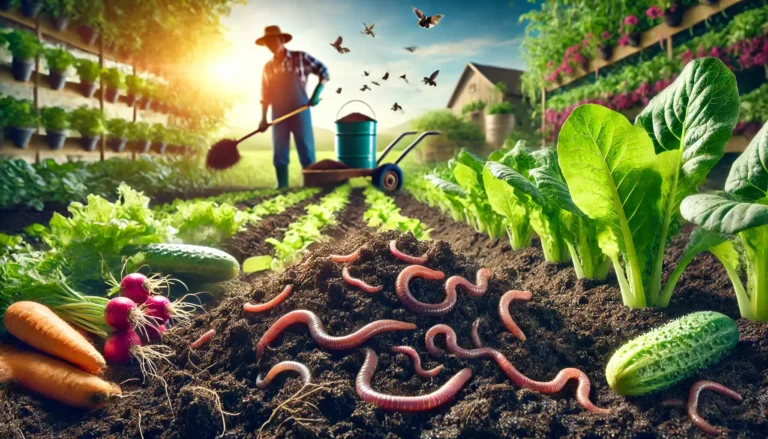
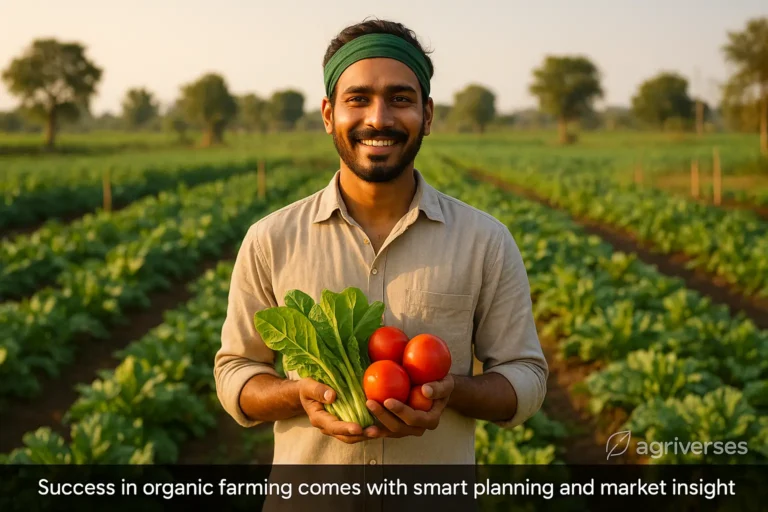
4 Comments